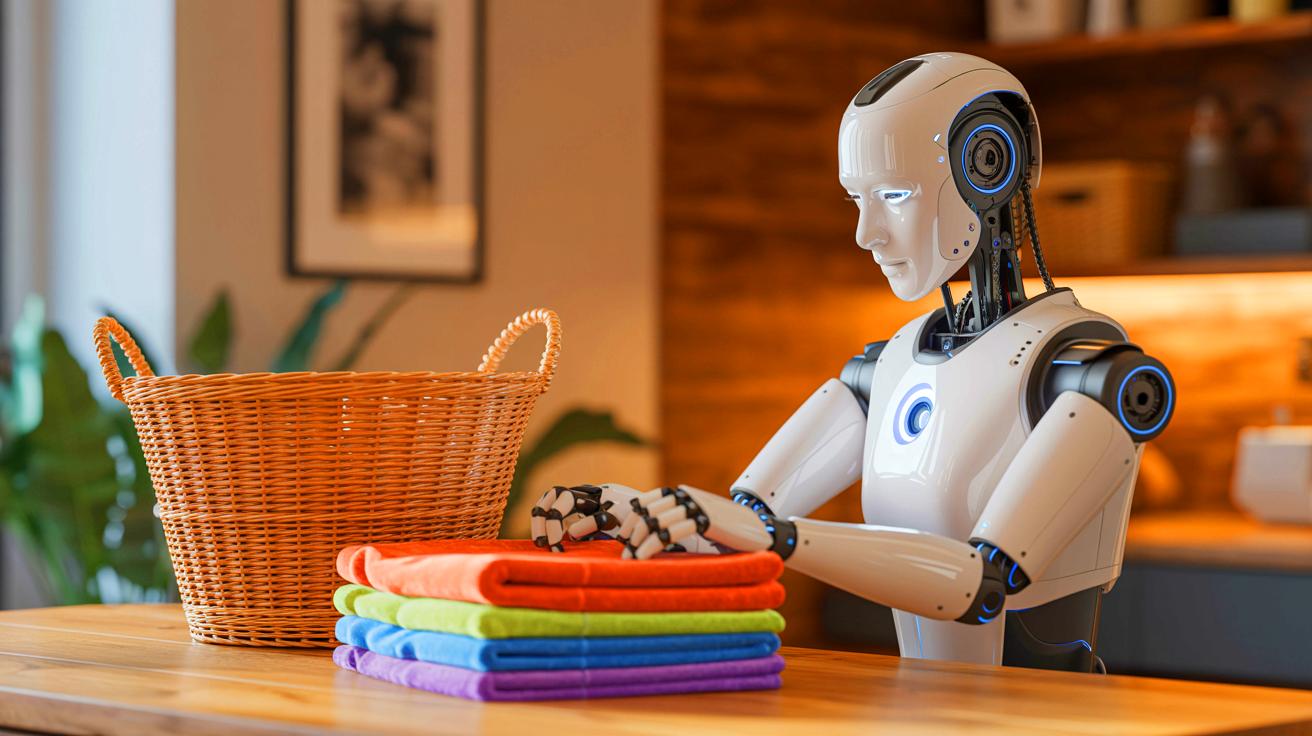- 🤖 Figure’s Helix AI model showcases a humanoid robot folding laundry with human-like precision.
- 🔧 The Helix system integrates vision, language, and action, enhancing robotic adaptability and intelligence.
- ⚙️ Operating on low-power GPUs, Helix enables multi-robot collaboration and handles complex tasks efficiently.
- 💡 The advancements in robotics raise societal and ethical questions about the future integration of intelligent machines.
In the realm of robotics, Figure’s Helix AI model is making headlines by redefining how robots interact with their environment. Demonstrated in a recent video, the Helix-powered humanoid robot showcased its ability to fold towels with a surprising degree of skill and precision. This development marks a significant advancement in the field of robotics, where the integration of vision, language, and action models is paving the way for machines that can perform complex tasks with human-like adaptability. With Helix, Figure aims to overcome traditional robotics challenges, setting a new standard for what these machines can achieve in daily life.
AI Powers Precision
The introduction of Figure’s 02 humanoid robot highlights the potential for AI-powered precision in robotics. Tasked with folding towels, the robot approaches the task with care, demonstrating a level of patience and meticulousness that challenges preconceived notions of robotic capabilities. As the robot handles each towel, its movements are steady, albeit occasionally imperfect, reflecting a focus on task completion over exactness.
Central to this capability is the Helix AI model, which facilitates sophisticated control of the robot’s upper body. Its ability to move wrists, torso, head, and fingers at high speeds enables more human-like interactions. Notably, Helix allows for multi-robot collaboration, enabling synchronized efforts on shared tasks, even with unfamiliar objects. This is achieved using a single neural network for multiple behaviors, eliminating the need for specific task tuning and enhancing the system’s versatility.
Operating on low-power GPUs, Helix is optimized for real-world applications, combining nuanced control and adaptability. This innovation sets a new benchmark in the field, reflecting a leap in generalist humanoid robot capabilities within complex, everyday environments.
Robots Learn Faster
Helix is designed to address the limitations of existing robotic systems, which often struggle with adaptability and require extensive programming or demonstrations. Figure’s solution leverages Vision-Language Models (VLMs) to enable robots to understand spoken commands and generalize actions as needed. This approach is built on two core components: System 1 (S1) and System 2 (S2). S1 translates insights into real-time actions, while S2 handles language and scene comprehension.
This separation of responsibilities allows for independent upgrades and enhances the robot’s ability to manage complex reasoning and timely execution. Helix’s architecture balances speed and generalization, scaling to high-dimensional actions while maintaining simplicity. The training involved approximately 500 hours of teleoperated behaviors, complemented by natural language instructions generated by an auto-labeling VLM.
By processing visual inputs into latent representations, Helix improves adaptability and accelerates learning, making it a practical solution for various robotic applications. This advancement underscores the potential for AI to revolutionize how robots learn and interact with their surroundings.
A Leap Toward Generalist Robots
Figure’s Helix model represents a significant leap toward the development of generalist robots capable of performing a wide array of tasks. By integrating vision, language, and action, Helix overcomes many of the longstanding challenges in robotics, such as interpreting surroundings, understanding instructions, and executing complex tasks. The aim is to create robots that can seamlessly adapt to new environments and tasks without extensive reprogramming.
Helix’s ability to process multiple behaviors through a single neural network makes it a versatile tool for developers. This unified approach streamlines the development process and expands the range of potential applications. The model’s low-power operation ensures that it is not only effective but also efficient, making it suitable for commercial deployment.
As robotics technology continues to evolve, models like Helix are paving the way for more adaptable and capable machines. This progress raises important questions about the future of robotics and the role these machines will play in our daily lives.
The Future of Robotics
The advancements presented by Figure’s Helix model invite a broader discussion on the future of robotics and their integration into everyday life. As these machines become more capable of understanding and executing complex tasks, they have the potential to transform industries and redefine labor. The ability of robots to learn quickly and adapt to new environments may soon lead to their widespread adoption in various sectors.
However, this technological progress also raises ethical and societal questions. As robots take on more roles traditionally performed by humans, the implications for employment and the economy must be carefully considered. Furthermore, the integration of AI into robotics requires ongoing evaluation to ensure that these systems operate safely and ethically.
As we look toward the future, we must ask: How will society adapt to the increasing presence of intelligent robots, and what measures will be necessary to ensure their responsible use?
This article is based on verified sources and supported by editorial technologies.
Did you like it? 4.6/5 (29)
